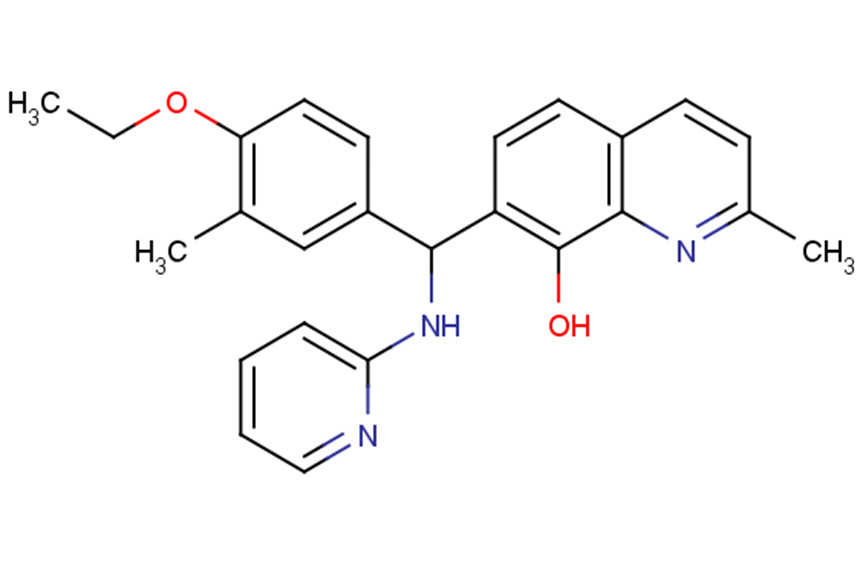
HLM006474
CAS No. 353519-63-8
HLM006474( —— )
Catalog No. M22127 CAS No. 353519-63-8
HLM006474 is a pan inhibitor of E2F. This inhibits E2F4 DNA-binding (IC50: 29.8 μM in A375 cells).HLM006474 causes the viability of both SCLC and NSCLC lines (IC50 ranging from 15 to 75 μM). HLM006474 displays little activities against E2F4 DNA-binding in A375 cells at 10 and 20 μM, apparently inhibits E2F4 DNA-binding at 40 μM, and increasingly suppresses the effect at 60 and 80 μM concentrations.
Purity : >98% (HPLC)
 COA
COA
 Datasheet
Datasheet
 HNMR
HNMR
 HPLC
HPLC
 MSDS
MSDS
 Handing Instructions
Handing Instructions
| Size | Price / USD | Stock | Quantity |
| 2MG | 34 | In Stock |


|
| 5MG | 55 | In Stock |


|
| 10MG | 79 | In Stock |


|
| 25MG | 149 | In Stock |


|
| 50MG | 266 | In Stock |


|
| 100MG | 441 | In Stock |


|
| 500MG | 981 | In Stock |


|
| 1G | Get Quote | In Stock |


|
Biological Information
-
Product NameHLM006474
-
NoteResearch use only, not for human use.
-
Brief DescriptionHLM006474 is a pan inhibitor of E2F. This inhibits E2F4 DNA-binding (IC50: 29.8 μM in A375 cells).HLM006474 causes the viability of both SCLC and NSCLC lines (IC50 ranging from 15 to 75 μM). HLM006474 displays little activities against E2F4 DNA-binding in A375 cells at 10 and 20 μM, apparently inhibits E2F4 DNA-binding at 40 μM, and increasingly suppresses the effect at 60 and 80 μM concentrations.
-
DescriptionHLM006474 is a pan inhibitor of E2F. This inhibits E2F4 DNA-binding (IC50: 29.8 μM in A375 cells).HLM006474 causes the viability of both SCLC and NSCLC lines (IC50 ranging from 15 to 75 μM). HLM006474 displays little activities against E2F4 DNA-binding in A375 cells at 10 and 20 μM, apparently inhibits E2F4 DNA-binding at 40 μM, and increasingly suppresses the effect at 60 and 80 μM concentrations. HLM006474 dramatically causes cyclin D3 protein expression and is a potent inducer of PARP cleavage[1]. HLM006474 (20 μM) weakly synergizes with paclitaxel, but there is antagonism between HLM006474 and cisplatin and gemcitabine in H1299 cells[2]. HLM006474 (40 μM) inhibits E2F4 activity via suppression of its DNA-binding activity and down regulation of its expression and HLM006474 (40 μM) also obviously causes apoptosis in A375 and 231 cell lines for 24 hours. HLM006474 (60 μM) enhances the expression of several known E2F-regulated genes after short treatments in H292 and H1299 cell lines. HLM006474 leads to a reduction in the mRNA levels of MAD2. HLM006474 apparently suppresses the increase of Mad2 protein and pRb-S780 signal but not the level of Skp2 protein in human lung cancer A549 cellss.
-
In VitroHLM006474 shows little activities against E2F4 DNA-binding in A375 cells at 10 and 20 μM, apparently inhibits E2F4 DNA-binding at 40 μM, and increasingly suppressses the effect at 60 and 80 μM concentrations. HLM006474 (40 μM) inhibits E2F4 activity via suppression of its DNA-binding activity and down regulation of its expression. HLM006474 (40 μM) also significantly induces apoptosis in A375 and 231 cell lines for 24 hours. HLM006474 dramaticly reduces cyclin D3 protein expression, and is a potent inducer of PARP cleavage. HLM006474 reduces the viability of both SCLC and NSCLC lines with IC50 ranging from 15 to 75 μM. HLM006474 (60 μM) increases the expression of several known E2F-regulated genes after short treatments in H292 and H1299 cell lines. HLM006474 (20 μM) weakly synergizes with paclitaxel, but there is antagonism between HLM006474 and cisplatin and gemcitabine in H1299 cells. HLM006474 leads to a decrease in the mRNA levels of MAD2. Furthmore, HLM006474 apparently suppresses the increase of Mad2 protein and pRb-S780 signal but not the level of Skp2 protein in human lung cancer A549 cellss.
-
In Vivo——
-
Synonyms——
-
PathwayOthers
-
TargetOther Targets
-
RecptorE2F4 DNA-binding
-
Research Area——
-
Indication——
Chemical Information
-
CAS Number353519-63-8
-
Formula Weight399.48
-
Molecular FormulaC25H25N3O2
-
Purity>98% (HPLC)
-
SolubilityDMSO:24 mg/mL (60.08 mM; Need ultrasonic)
-
SMILESCCOc1ccc(cc1C)C(Nc1ccccn1)c1ccc2ccc(C)nc2c1O
-
Chemical Name——
Shipping & Storage Information
-
Storage(-20℃)
-
ShippingWith Ice Pack
-
Stability≥ 2 years
Reference
1. Ma Y, et al. A small-molecule E2F inhibitor blocks growth in a melanoma culture model. Cancer Res. 2008 Aug 1;68(15):6292-9.2. Kurtyka CA, et al. E2F inhibition synergizes with paclitaxel in lung cancer cell lines. PLoS One. 2014 May 15;9(5):e96357.
molnova catalog



related products
-
YTK-105
YTK-105 is a ligand targeting autophagy that binds to p62.
-
alpha-Viniferin
α-Viniferin belongs to a class of organic compounds, also known as 2-arylbenzofuran flavonoids, that are inhibitors of prostaglandin H2 synthetase. α-Viniferin has anti-Alzheimer's disease, anti-tuberculosis, anti-tumor, anti-inflammation, anti-diabetes and other pharmacological activitie.
-
Pro-TGF-a
Pro-TGF-a



 Cart
Cart
 sales@molnova.com
sales@molnova.com


